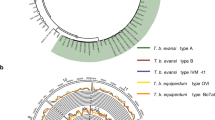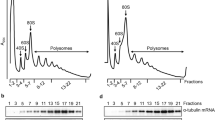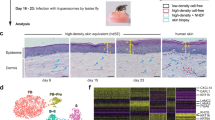Abstract
THE trypanosomes belonging to the Trypanosoma brucei group (agents of sleeping sickness and nagana) exist in the blood of the host in three main morphological forms—long thin, intermediate and short stumpy. When these are taken up by the tsetse fly they undergo developmental changes, namely trypanosome, crithridial and metacyclic forms, the last being infective to the vertebrate host. There is controversy about which forms are infective to the fly, the long thin, the short stumpy or both.
This is a preview of subscription content, access via your institution
Access options
Subscribe to this journal
Receive 51 print issues and online access
$199.00 per year
only $3.90 per issue
Buy this article
- Purchase on SpringerLink
- Instant access to full article PDF
Prices may be subject to local taxes which are calculated during checkout
Similar content being viewed by others
References
Polge, C., and Soltys, M. A., Trans. Roy. Soc. Trop. Med. Hyg., 51, 519 (1957).
Cunningham, M. P., Lumsden, W. H. R., and Webber, W. A. F., Exp. Parasit., 14, 280 (1963).
Cockings, K. L., Rep. E. Afr. Tryp. Res. Org., 1959, 13 (1960).
Cunningham, M. P., and Harley, J. M. B., Nature, 194, 1186 (1962).
Cunningham, M. P., Rep. E. Afr. Tryp. Res. Org., 1960, 14 (1961).
Ormerod, W. E., Healey, P., and Armitage, P., Exp. Parasit., 13, 386 (1963).
Corson, J. F., Trans. Roy. Soc. Trop. Med. Hyg., 28, 501 (1935).
Corson, J. F., Trans. Roy. Soc. Trop. Med. Hyg., 30, 207 (1936).
van Hoof, L., Trans. Roy. Soc. Trop. Med. Hyg., 40, 728 (1947).
Baker, J. R., and Robertson, D. H. H., Ann. Trop. Med. Parasit., 51, 121 (1957).
Robertson, M., Proc. Roy. Soc., B, 85, 527 (1912).
Wijers, D. J. B., and Willett, K. C., Ann. Trop. Med. Parasit., 54, 341 (1960).
Vickerman, K., Nature, 208, 762 (1965).
Buxton, P. A., The Natural History of Tsetse Flies (H. K. Lewis, London, 1955).
Author information
Authors and Affiliations
Rights and permissions
About this article
Cite this article
MSHELBWALA, A. Infectivity of Trypanosoma rhodesiense to Tsetse Flies fed through Animal Membranes. Nature 215, 441 (1967). https://doi.org/10.1038/215441a0
Received:
Revised:
Issue date:
DOI: https://doi.org/10.1038/215441a0



